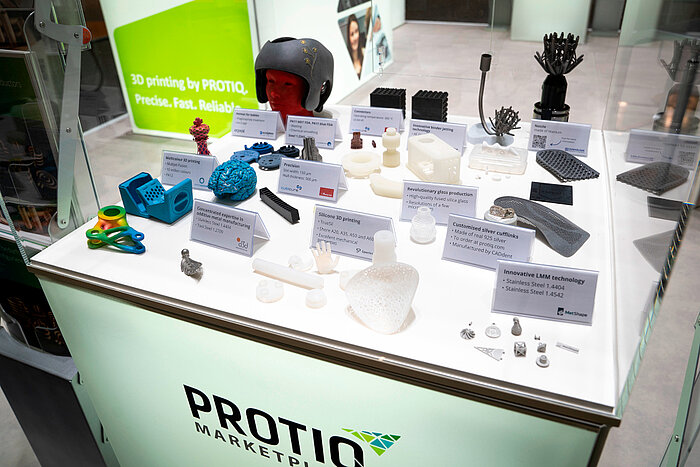CADdent at the Formnext 2023
Formnext 2023: four days of trade fair in Frankfurt. The international elite in the field of additive manufacturing (AM) and modern industrial production were on show. As one of the industry leaders in digital dental technology, we from CADdent were there as an exhibitor. Our in-house Research and Development department invests a lot of time, ideas and innovation in additive processes such as LaserMelting and 3D printing with various ceramics, precious metals, titanium and polymers, ideal for even the most delicate and complex structures. At Formnext, we presented the future of CADdent, found out about current trends in additive manufacturing outside the dental industry and took away innovations that we will subsequently examine, test for feasibility and implement. Keywords: rapid prototyping, rapid tooling and rapid manufacturing, for time and cost savings combined with the highest functional and esthetic demands of dental medicine.
CADdent's commitment to rapid prototyping: beyond dental technology
At Formnext 2023, we demonstrated our expertise in the field of rapid prototyping - an expertise which goes far beyond the dental sector. Our rapid prototyping department, equipped with state-of-the-art technologies and a team of experienced experts, presented innovative applications and solutions. These range from the development of complex prototypes to the efficient production of small series. Through the combination of fast responsiveness and know-how from dental technology, where the highest levels of precision and reliability are required, we at CADdent have established ourselves as a versatile and valuable partner for various industries.
Cross-industry impulses and synergies
At the trade fair, our experts emphasized the importance of synergies between different industries. The processes and technologies developed in the field of rapid prototyping are not only pioneering in the dental sector, but also offer significant advantages for industries such as automotive engineering, medical technology, mechanical engineering and aerospace technology. CADdent's ability to transfer the specific requirements for precision and attention to detail from dental technology to other areas of application is particularly noteworthy. This transfer of specialist knowledge and technological expertise enables CADdent to act as an innovation leader and offer customized, efficient solutions beyond the dental industry.
Synergy effects between dental technology and rapid prototyping
The knowledge and advances in rapid prototyping gained at Formnext are not only important for us at CADdent, but also for the entire dental industry. The advanced manufacturing techniques and precision engineering perfected in our Research and Development department have a direct impact on the quality and efficiency of our dental products. These synergies between the two areas contribute significantly to the fact that we develop innovative solutions for the challenges in dental technology and at the same time set new standards in terms of quality and precision.
Formnext: news for the dental industry?
Back to the CADdent origin: dental technology. This is what we take away from Formnext: the assessment of key topics such as (multi-) material printing, automated set-up and production processes as well as material certifications as industry-important potential for dental technology.
(Multi-) material printing
3D printing is the future of dental technology. The reason for this is the almost unlimited range of geometries which can be realized, as well as the low material consumption and the material mix. Currently, the range of printable materials for dental indications is still limited compared to applications in other sectors, such as the automotive industry. Making new materials, including material mixes such as the processing of ceramic and metal, printable for permanent biocompatible use in the oral environment is a challenge. The 3D printing of bone replacement materials with high bioresorbability, osteoconductivity and fully regenerative healing could become a real alternative for jaw augmentations in the dental sector. One example is glass printing - the use of molten glass, heated to over 1000°C, followed by precise CAD shaping. The envisaged goal and a new 3D printing era would be to print the complete dental prosthesis - regardless of the material - in a single, time-saving process.
Automated set-up and manufacturing processes
Future vision 2023: 3D printers produce dental restorations quickly and cost-effectively using the additive process. This increases process productivity, and automated set-up and manufacturing processes reduce cost pressure. Software and new technologies support design, post-processing and quality control and lead to high output in the process chain.
Feasibility 2023: since individual restorations are required in dental technology, the creation of optimized and recurring batch sizes, as in industrial production, is not feasible. When it comes to saving time, personnel and materials, individualized dental 3D printing and digital workflow still score points in the face of cost pressure and a shortage of skilled workers in the dental sector.
Material certifications
Materials science is a challenging topic and the correct choice of suitable dental material is important for successful restorative care. All-ceramic materials such as zirconium dioxide, lithium disilicate or glass ceramics play an important role due to their very good technical properties and aesthetics and have the potential to overtake classic metal-veneering ceramics. The problem of additive dental manufacturing, using lithium disilicate as an example in 2023: 3D printing with this ceramic using litho technology is technically possible, but certification for dental applications is missing.
Competition from Asia?
Formnext was an ideal location for international market observation in dental technology and additive manufacturing. Our summary with a view to the Far East: offers from Asia with low prices are flooding the market across all sectors. However, the quality of manufacturing and materials in the dental sector cannot keep pace with the high-quality solutions from the European region.
CONCLUSION
CADdent at Formnext 2023 – building bridges between industries: At Formnext, dental technology is a niche industry when it comes to additive manufacturing. However, one with a lot of potential in terms of current developments in other leading industrial sectors such as automotive, mechanical engineering, electrical and chemical. By transferring innovations and best practices between these areas, we position ourselves as a pace-setter who not only advances dental technology, but also absorbs and adapts impulses from other leading industrial sectors. This holistic approach demonstrates our commitment to continuous innovation and excellence across the boundaries of individual disciplines.

